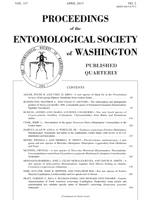Vanduzea segmentata, a membracid of the smiliine tribe Amastrini, was known only from the western United States and Mexico until it was reported from Louisiana in the 1930s. A collection in the Florida Panhandle in 1954 represented the first record east of the Mississippi River; the first record from peninsular Florida was 2001. The membracid has remained known in southeastern states only from Florida and Louisiana, with scant data available on its bionomics. We give the first records of V. segmentata from Alabama and Georgia, noting features that distinguish it from other species of Vanduzea in the Southeast, and review its previously published U.S. distribution and plant associations. We found nymphs and adults mainly on mimosa, or silk tree (Albizia julibrissin Durazz.; Fabaceae), but other fabaceous species and composites (Asteraceae) also were hosts. Periodic sampling of mimosa in southeastern Georgia indicated that the membracid is trivoltine, with overwintered eggs beginning to hatch in mid-March and first-generation adults appearing by late April. Early instars of the first generation fed initially on buds and later on unfolded leaflets and young stems. Nymphs of following generations also fed on vegetative parts and on surfaces of green fruits (pods) and peduncles (stalks) of brown pods. Adults, and in some years nymphs, were present until late November. Vanduzea segmentata primarily was tended by the invasive Argentine ant, Linepithema humile (Mayr). On mimosa, it was typically found in small aggregations of 2–6 individuals, although considerably larger aggregations can be found on herbaceous hosts. The membracid's eastern range expansion might have been facilitated by the abundance of mimosa and other adventive plants with extrafloral nectaries, and the presence of L. humile, a South American ant that establishes mutualisms with honeydew-producing hemipterans and might be more efficient at protecting them from predators and competitors than are native ants.
BioOne.org will be down briefly for maintenance on 12 February 2025 between 18:00-21:00 Pacific Time US. We apologize for any inconvenience.
Home
>
Journals
>
Proceedings of the Entomological Society of Washington
>
Volume 117
>
Issue 2
>
Article
How to translate text using browser tools
12 June 2015
Vanduzea segmentata (Fowler) (Hemiptera: Membracidae): Seasonality and Habits in the Southeastern United States, with Review of Its U.S. Distribution and Host Plants
Alan W. Harvey,
A. G. Wheeler Jr
ACCESS THE FULL ARTICLE
Argentine ant
extrafloral nectaries
mutualism
new records
treehopper
trivoltinism





